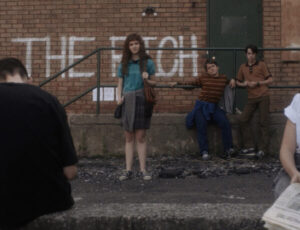Last week while flipping through my Netflix suggestions, a certain film caught my eye. Detropia, directed by Heidi Ewing and Rachel Grady, is a somber and artful look at the steady decline of one of America’s great cities. I’m a sucker for current events and since the city of Detroit filed for bankruptcy mere weeks ago, making it the largest city in the history of the United States to do so, I decided to dive in. The film takes a look at Detroit in 2010 and meshes together the depressing facts of the city’s decline, along side footage of several citizens attempting to salvage it and carry on life as normal.
Although most anyone could see Detroit’s crash from a mile away, it is still disturbing to see a city fall within such a short period of time. In 1930, Detroit was America’s fastest growing city. In 2012 it was the fastest shrinking, with over a 100,000 abandoned lots and homes. The collapse of the auto industry accelerated Detroit’s decline and led to masses of people fleeing the city in search of greener pastures. Detropia balances facts such as these with sojourns into the lives of current Detroit residents. We meet Crystal Starr, a video blogger, Tommy Stephens a former schoolteacher who now runs a bar, and George McGregor the United Auto Workers local president. We also get a glimpse into the local government and their efforts to save the city. It’s clear from all we witness that the prospects of the city during Detropia’s shoot are incredibly grim.
The film’s focus on ordinary people is refreshing. Rather than just talking about struggle and hope, we see it. Apart from its subjects, the other standout feature of Detropia is its sweeping atmospheric soundtrack. The music is played along with images of the city’s many abandoned and decaying buildings. For all its troubles, there is still beauty to be found in Detroit.
Detropia also uncovers evidence that Detroit may cycle back, though the true beneficiaries of this supposed resurgence remains to be seen. Although the 2012 census showed the city has shrunk to just over 700,000 people, the inner city has seen a rise in young people moving in. Ewing and Grady briefly focus on Steve and Dorota Coy, young, white artists who have fallen in love with the “affordable” city and use it as a testing ground for their art. Their spirit is commendable and the hope that art can help to revitalize the city is a wonderful possibility. However, I couldn’t help but cringe when Steve Coy notes that if he fails here, it’s ok because it won’t be like hitting rock bottom. The power of that statement is like a slap in the face. Coy is surrounded by people who are struggling to hold on, and don’t have the luxury of taking advantage of the spoils of an increasingly deserted city. Obviously such low real estate values would be a welcome sign to young artists, and it is heartening to see art come out of a once industrial city, but the contrast is borderline sickening.
The film makes an effort to portray art and privilege as going hand in hand by switching between footage of the lives of its subjects, with performances from the Detroit Opera House. Again, while it is hopeful to see the artistic venue continuing, one wonders who can afford to attend these performances.
Despite its striking visuals and interesting cast of everyday people, the film doesn’t have enough meat to keep it going strong from start to finish, and begins to drag in the last third. The few observational gems hit upon along the way don’t add much fuel to the tank. And yet, although this snapshot of a city on the brink of collapse may be long-winded and faltering, it is still worth looking at as a warning of things to come. Despite its probable restoration, it would not be difficult to imagine this happening to other major cities around the world as jobs are outsourced and debt runs rampant.








